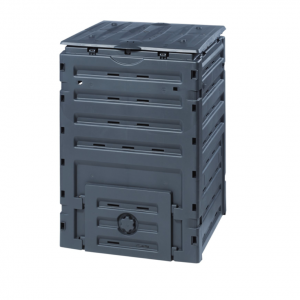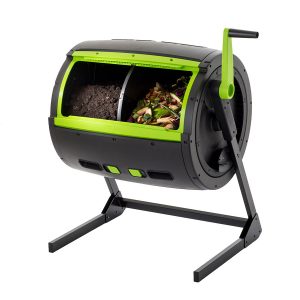Our Bokashi Composter is designed to collect kitchen scraps and initiate the breakdown of organic material.
A compost bin or tumbler is primarily used to convert kitchen and garden waste into usable compost.
If you live in a flat and don’t have a garden, a Bokashi bucket would be adequate, provided you have access to land where you can bury the fermented scraps. Worm farms can also be used also for converting many kitchen scraps (not meat, fish and dairy products) into useful organic products and liquid fertiliser.
We find that the best set up, room and garden permitting, involves using both Bokashi system in conjunction with an outdoor composter.
Our Bokashi Composters can accommodate all organic kitchen scraps (including meat, fish and dairy products). The addition of Bokashi microbes begins the process of decomposition through fermentation and minimizes any unpleasant odours. Emptying is only necessary once the unit is filled.
The Kitchen Caddy on the other hand has to be emptied more often (at least once or twice per week). It is also not recommended that you collect meat, fish, and dairy products in Kitchen Caddies as without Bokashi microbes they will begin to rot and emit unpleasant odours.
You can make perfectly good compost without mixing or turning the heap, especially if you have mixed up the various types of material before adding them to the bin.
If your compost tends to be rather too dry or too wet (or you are not sure how it is going), mixing the contents of the bin now and again gives you the opportunity to adjust the balance of materials. It can also speed up the process if the heap was short of air. Simply lift the bin off the heap. Mix everything up – adding extra material to make it wetter or drier if required then put it all back into the bin.
Turning and mixing is made easy with a compost tumbler. However, material in a tumbler tends to dry out, and you need to make sure it is sufficiently moist for the composting process to proceed effectively.
Yes, if ‘Greens’ (e.g. grass clippings and vegetable scraps) and fine ‘Browns’ (e.g. shredded leaves and dry herbaceous plants) are composted in a tumbler that is kept moist, turned regularly and kept in a sunny position.
To make compost quickly in a stand alone bin you will need to fill it completely in one go using a good mixture of green and brown materials (chopped up or shredded if chunky). You will notice that the contents of the bin will begin to get hot in a few days (this is a good thing!). Once they have cooled down, mix the heap well with a pitch fork or compost aerator. This keeps the pile uniform in consistency and helps introduce oxygen to the microbes. Keep on mixing every few days until the heap has turned into usable compost.
It is also important to note that external temperatures play an important part in the rate at which organic waste can decompose into compost. This is the reason why composting is faster in summer than in winter.
A compost activator is simply something that gets the composting process started.
Grass clippings or other fresh green plant material will work as well as any activator that you could buy.
While some autumn leaves are a useful ‘Brown’ material to balance out too much wet material in a compost heap, large quantities of leaves can actually slow down the decomposition of organic waste.
If you have a large quantity of leaves, instead of adding them to your composter, you can add them, wet, into black plastic sacks (or into a simple wire mesh container) and leave them to rot for a year. They will eventually turn into ‘leaf mould’, which is a good soil conditioner and potting compost ingredient.
Fresh lawn clippings can be composted if you have plenty of ‘Browns’, such as autumn leaves, tree/shrub cuttings, or paper / cardboard to balance the mixture.
If you still have too many grass clippings for the compost heap, just leave them on the lawn in summer. They will soon disappear back into the grass (this works best if your mower has a ‘mulching’ mode).
Rat/mice infestation is becoming increasingly common these days in suburban areas.
It is difficult to make your compost bin 100% rat proof. You can deter rats by lining the base, sides or top of the bin with a heavy-duty metal mesh. The mesh holes should be less than 1.5cm in diameter. Chicken wire is not suitable. The most effective mesh is the type used by builders to strengthen concrete.
There are bins which have bases available designed to prevent pests entering. Your compost bin should also have a tightly fitting lid that can be clamped on.
Compost tumblers might also be a solution as they are off the ground, and fully enclosed.
Slugs are a useful part of the composting process and will stay feeding in the bin. When you finally spread the finished compost any slug eggs that might be present are likely to dry out before they can hatch. A compost bin will also harbour other creatures that eat slugs – so keep composting!
Annual weeds are fine to compost. If they have gone to seed they will still compost well, though you are likely to get seedling weeds growing in the compost when you apply it to the garden. These can easily be hoed off, or you can dig the compost into the soil to reduce germination.
Persistent perennial weeds that spread easily, such as Madeira vine, couch grass and bindweed are best kept separate. Put them in a black plastic sack with some grass clippings and leave them in the sun to rot for up to six months. Once all signs of the roots have disappeared, add the sludge to your compost heap.
Alternatively put perennial weeds into your organics collection bin or take them to your local green waste collection site. Large-scale commercial compost heaps heat up to high temperatures (> 60C) that kills them off.
Yes, as long as you take the usual hygiene precautions.
Keep any cuts covered, wear gloves when handling compost and wash hands well after handling any compost.
Yes.
There seems to be a common misconception that citrus peel shouldn’t be added to a compost heap. It will compost when mixed with other ingredients.
When you open the lid of your compost bin, you may notice all sorts of little creatures in the compost. These creatures are all part of the cycle of natural decomposition and should be left to do their work.
These are fruit flies. They are harmless and all part of the natural cycle of decomposition.
They tend to appear in warm weather, especially when there are lots of kitchen organics on the compost heap. If they bother you, try covering the kitchen organics with a layer of something else less appealing .
If you keep the lid of the bin ajar the flies will not build up in such numbers, although this may give access to other animals.
Tough and chunky items will compost much more quickly if chopped or shredded. A power shredder is great if you have a lot of woody cuttings and evergreen hedge clippings to deal with. Small home shredders are often not powerful enough to be efficient.
It is probably more cost efficient to hire a shredder now and again, or to share a larger shredder with neighbours and friends.
You can use compost as one of the ingredients in a homemade seed or potting compost, but on its own, it would be too rich. Two-year-old leaf mould makes good sowing compost on its own.
Fresh clippings (whole or shredded) can be used for mulch on pathways or under mature trees. For other uses they should ideally be at least partially composted before use. Given that they usually come in large quantities we recommend keeping them into a separate compost heap.
When setting up your separate compost heap you should first put the hedge clippings through a shredder if possible. As you fill your composter with the clippings make sure to water the material as you go. Also try and to add alternate layers of grass clippings, manure and blood & bone (alternatively you can use a nitrogen rich liquid to moisten). Once finished, cover the heap and leave to decompose for at least 3 months. At the end of 3 months the clippings should appear dark brown in colour. At this point they can now be used as mulch on shrubberies and other established plantings. You can also leave them to further decompose into actual compost for your veggies and plants.
While many diseases can only survive on living plants, other diseases such as white rot, sclerotinia, wilts and clubroot can continue to prosper in the soil without any viable host.
Bottom line: If in any doubt as to the nature of the affliction it is probably a good idea to err on the side of caution and not add the diseased plant to your compost mix.
Ready to have a positive impact on the planet?
Subscribe to our newsletter to get tips and advice for keeping your sustainable garden looking great and performing well all year round!


